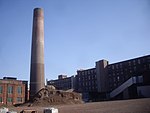NX Bridge
Bascule bridges in the United StatesBridges completed in 1922Bridges in Hudson County, New JerseyBridges in Newark, New JerseyBridges over the Passaic River ... and 5 more
Erie Railroad bridgesHistoric American Engineering Record in New JerseyKearny, New JerseyRailroad bridges in New JerseyUse mdy dates from January 2019

The NX Draw (sometimes colloquially known the "Annie Bridge") is an out-of-service railroad bridge on the Passaic River between Newark and Kearny, New Jersey. It is the 13th bridge from the river's mouth at Newark Bay and is 6.5 miles (10.5 km) upstream from it. The bascule bridge (sometimes called a jackknife bridge), built by the Erie Railroad and once part of its Newark Branch, has been abandoned in the raised position.
Excerpt from the Wikipedia article NX Bridge (License: CC BY-SA 3.0, Authors, Images).NX Bridge
Passaic Avenue,
Geographical coordinates (GPS) Address Nearby Places Show on map
Geographical coordinates (GPS)
| Latitude | Longitude |
|---|---|
| N 40.7544 ° | E -74.1643 ° |
Address
Passaic Avenue
07032
New Jersey, United States
Open on Google Maps











